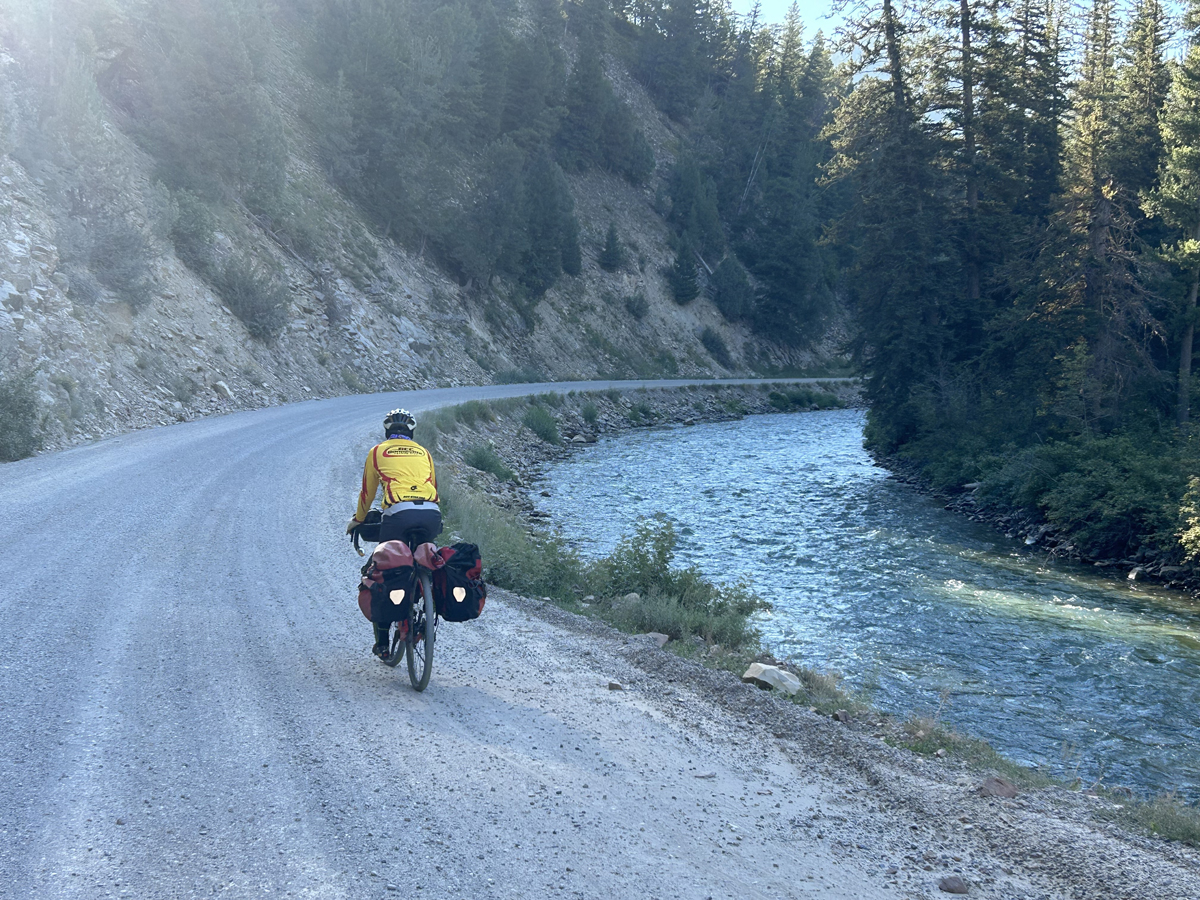By Martin Neunzert — They say life’s what happens as we try to re-center from the little detours chance puts in our path. Here’s a little story that encircles medicine, perseverance and evolving bicycle technology and chronicles three trips on the White Rim Trail in Southern Utah taken over the last 33 years.
December 1989:
CRAAARACK-ACK! The sound yerked me from half-sleep and echoed around the Wingate Sandstone cliffs, unseen above me in the darkness. What the…? It sounded like a rifle shot! In the middle of the night? At Hardscrabble Bottom, deep in the heart of Canyonlands National Park? When I had gotten my permit to camp on the White Rim, the ranger had chuckled and said, “You’re on your own!” to my query about there being anyone else in the area. I shivered the rest of the night away, and at first light threw everything into the panniers and rode as fast as I could to the sun. Once I got a good look at the Green River, I could see what had made the noise: Long shelves of ice had formed along the banks. When the water level dropped during the night, the shelves snapped off violently.
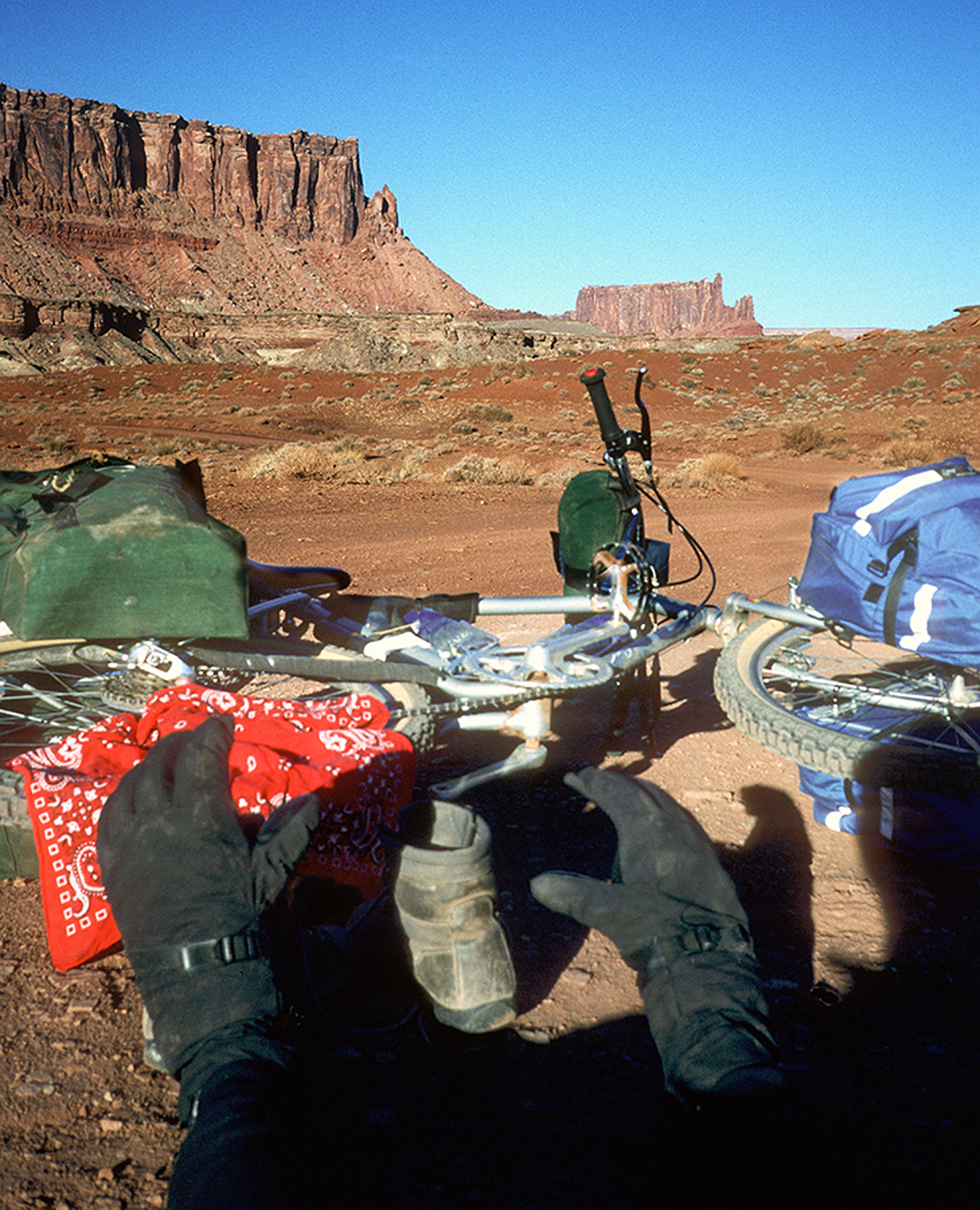
I had never been so cold. I had stripped my equipment well past the point of comfort—just a summer-weight synthetic sleeping bag and a bivy sack—in order to carry enough water. That night it was 14 degrees in Moab. The photo is of my feet wearing my heavy gloves in an attempt to get some feeling back into them.
September 2015:
A modern treatment for leukemia is to kill off the patient’s bone marrow, chemically, then rebuild it using stem cells from a suitable donor, my brother in my case. Although a miraculous procedure, the recipient’s body feverishly, literally, tries to reject the transplant. I ran a 104 degree fever for four days yet I felt intensely cold. Even under heated blankets, my uncontrollable shivering was so bad at times they gave me Demerol just so I could sleep for short periods.
November 2016:
PD and I stopped next to a woman standing at the edge of one of the uppermost switchbacks on the Shafer Trail. East of our toes, the road dropped 1,300 feet to the White Rim. A whooshing sound behind us caused us all to whip around. A guy on a mountain bike flew by. Nobody spoke for a few seconds, watching. “Can you believe he’s doing it in flats and tennis shoes?” the woman asked the sky. “He forgot his cleats this morning.” I turned slightly and half-stepped toward my bike so she couldn’t see my platform pedals and light hiking shoes. Then she was gone, too, and silence returned, in its enormity. I muttered “Try that with partial vision loss, anemia (only two-thirds the amount of red blood cells of normal), osteopenia, chemo-brain, persistent left-side weakness, and, depending on who you talk to, sleep apnea, elevated creatinine level and residual PTSD.”
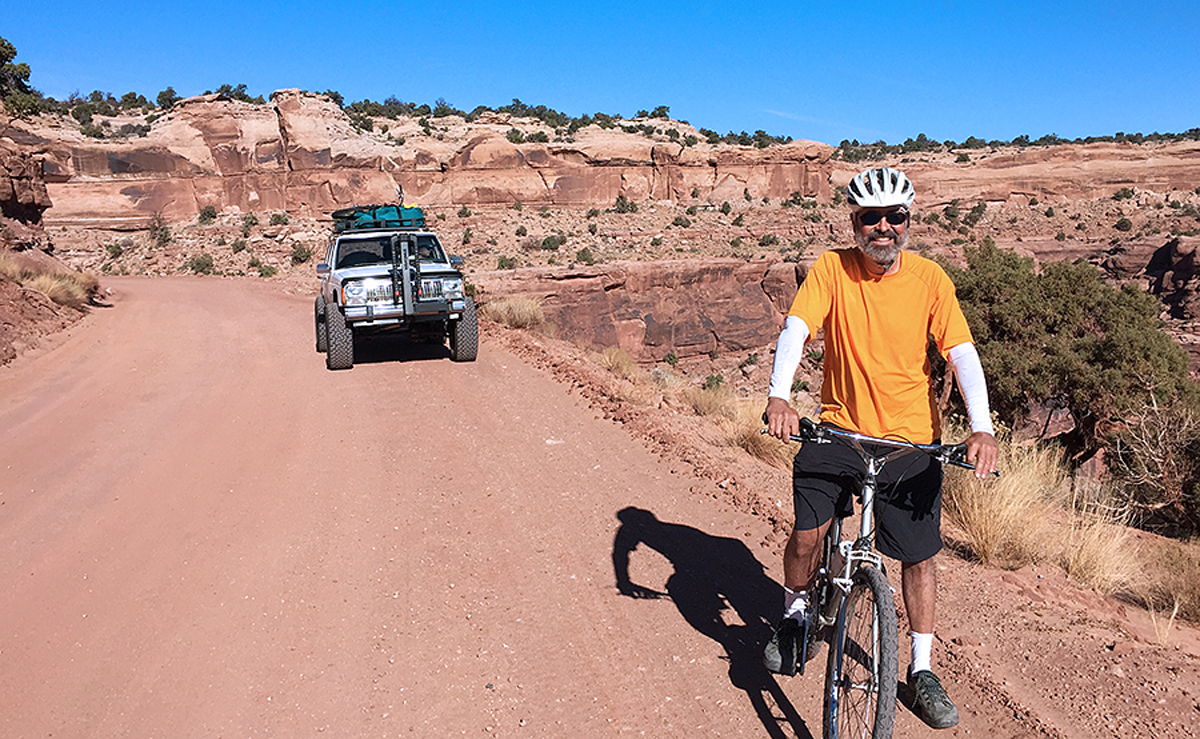
“I know who the real hero is,” PD said quietly.
Two switchbacks lower, we stopped again as some vehicles were bunched up. Young Dude asked “What kind of bike is that!?” His tone of voice hovered between complete incomprehension and incredulousness, as if he had only seen a lugged-and-brazed frame used as a rusty bike rack, bolted to a sidewalk outside a bike shop.
“It’s an antique…” I said, politely leaving unsaid the part that it was state-of-the-art before he was born. It was bikes like these that blew open the whole mountain biking industry. Want to see it? Go to the parking area at the Slickrock Bike Trail above Moab and find the little interpretive sign at the south end that provides the history of the Trail. Mine’s a twin to the one in the photo, except silver.
We weren’t out to be the first or to break records. After all, websites for bragging about your accomplishments wouldn’t go on-line for another twenty years. I wasn’t even sure mountain biking in the desert would be practical: Too hot, too big, too sandy. But with each experience, we gained confidence and efficiency, always dreaming of future adventures.
December 1989:
Somewhere near Candlestick Butte, a movement and clattering of rocks caused me to skid to a halt. A mature desert bighorn ram had come partway down a shaly slope, our paths crossing by incomprehensible randomness. He intently studied me, perhaps confused by my bull moose handlebars. I was in awe, and a little jealous. Until then, I had felt smugly autonomous, carrying all my water for four days, yet he thrived in this environment, sculpted by evolution, sustained by the instinctive drive to survive.
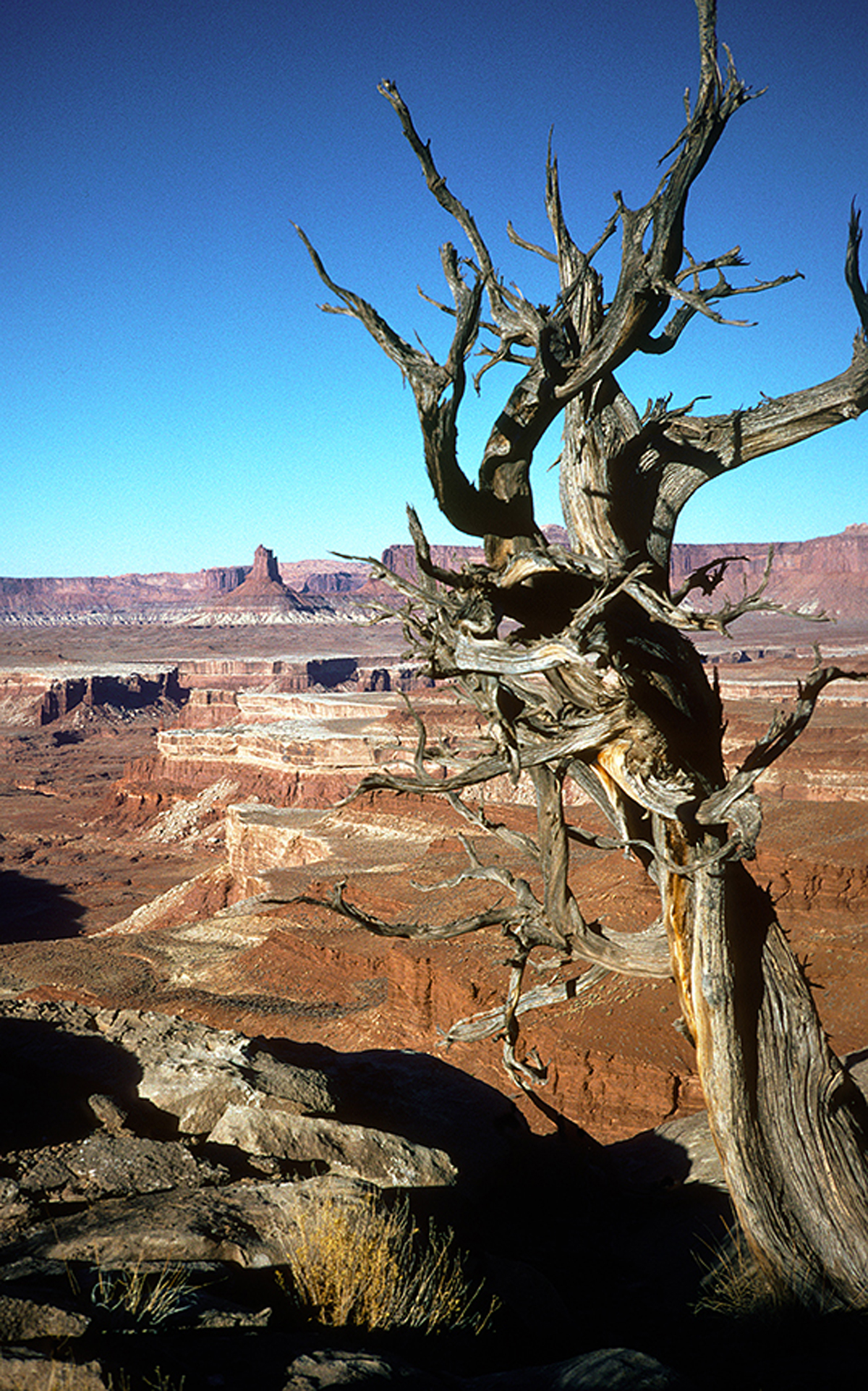
November 2016:
“Thank God for disc brakes!” another woman said, grinning and letting gravity take her easily down the fun descent off Murphy Hogback. I wondered if she knew what center-pull brakes were. I was confident they were capable of locking up the wheels even when loaded with all my camping gear and nine quarts of water. Then as now, logistics are the real challenge of cycling the White Rim. My first time around, I chose to do it solo and self-contained. I had managed to cache a gallon at Potato Bottom, but failed to place another near Monument Basin. But when the opportunity came, I adapted by figuring out how to carry enough and going when it wasn’t hot. Not once did it occur to me to mooch water the way modern bikepackers sometimes do, mostly because I truly value self-sufficiency, but partly because there was no one else.
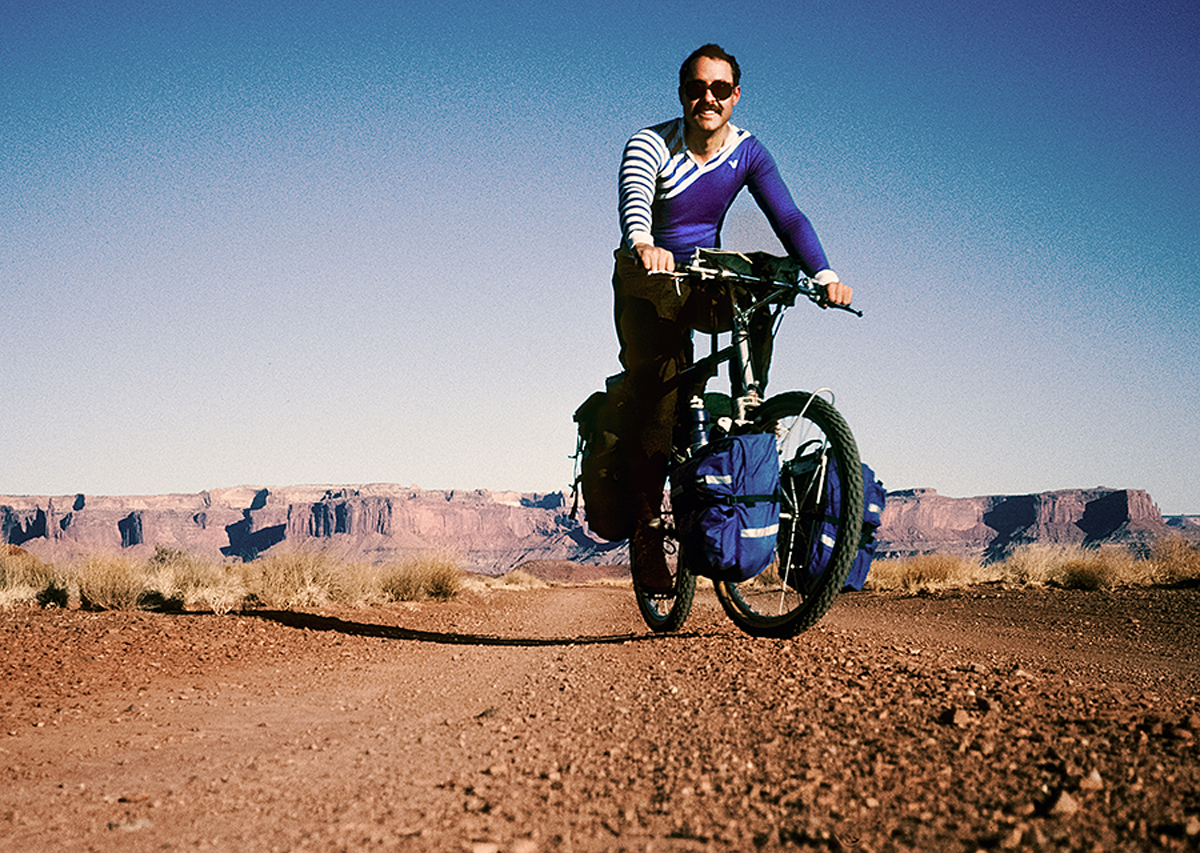
Out by the Black Crack, I stopped to take in the expansive panorama, from Ekker Butte to the Buttes of the Cross. “You’re riding a non-suspended bike?” Mister More-Brand-Logos-Than-Spokes asked, pulling alongside. I laughed because I could see he was in too much of a hurry to listen to me explain why I wasn’t on my full-suspension off-road recumbent, so I just answered, perhaps a little too flippantly, “Oh, I’ve been doing this for 30 years, I don’t know what the big deal is.”
“Well,” he replied, “It makes a big difference to your forearms!” and he flapped his hands as if he was shaking water from them. I flashed back to my initial days in rehab. After six weeks of immobilization from pneumonia and a stroke, my muscles were so weakened that my joints, particularly my knees and hips, would separate when I tried to relax or sleep. I don’t mind telling you I had never felt such exquisite pain. It got so bad I asked for Oxycodone several times. That was kind of scary in itself. My physical therapists thought I was working extra hard in the gym to get back on my bike, I just wanted to build up my strength to stop the pain.
But in the present, I watched him sprint away, no doubt a drum-machine-and-synthesizer soundtrack playing in his mind like in the bike porn videos. I sincerely hoped he would someday learn the value of developing skills, tenacity and patience…
When PD had invited me to ride the Rim again, I was terrified. It had been six months since I had tried to ride a diamond-frame bike, and that attempt had ended in a crash. But he refused to accede. I think my physical therapists had secretly gotten to him and persuaded him to find ways to get me back on the horse. I seriously considered moving him to the “ex-friends” category. Nevertheless, I was deeply curious to see if anything had changed in two-and-a-half decades. Fundamentally, no, nothing has. One still feels very insignificant out there in the vastness. But when I dragged into camp that evening at dusk, I sensed something was different.
Not just the breeze rustling the yellow cottonwood leaves, not the position of a cactus spine, definitely not the enduring sandstone that changes only imperceptibly during a human’s lifespan. No, it was I who had changed.
Cancer (and its treatment and complications) had, for a time, taken away my freedom, my sanity, my dignity, my hair, my balance, my mobility, strength, even my appetite, leaving me only with my determination. Now everything I do is, in some way, therapy in the long fight to return to some level of normalcy.
Just last week one of my docs mentioned she was amazed at how well I handled 22 days in the ICU, horribly uncomfortably proned, with what felt like a garden-hose-sized ventilator tube jammed down my throat. Inspirational tenacity? I’m not sure. I just did what it took to get through it. Perhaps there was an element of luck. One of the nurses in the ICU where they took me to after my stroke told me “In the six years I’ve worked here, you’re the only one who has survived the combination of acute myeloid leukemia, a bone marrow transplant, pneumonia and stroke.”
And I learned so much. Like genetics, the insane complexities of medicine or about being a professional patient. Stuff I never wanted to know that will now haunt me forever. Never again would I take for granted the profound compassion and intrinsic nonjudgmental nature of the myriad of people who helped me along the way. Or to be able to just jump on a bike and ride. Or to sleep under the rotating stars.
The White Rim Trail is a classic and deservedly popular 100-mile loop, mostly in Canyonlands National Park, mostly off-pavement.
Martin Neunzert is a long-time cyclist and tourer. He cycled the White Rim in 1989, 1990 and 2016 and has completed many other on- and off-road adventures along the way. He is now likely seen around Ogden, Utah, on his recumbent trike.








